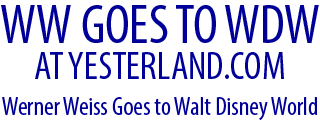|
|||
|
On November 18, 2010, The Walt Disney Company announced that Pleasure Island at Walt Disney World would become Hyperion Wharf. It would involve more than just renaming the former nightclub area. Concept art showed a vibrant “electric wonderland” at night. It seemed like a good idea—if overdue. It had been more than two years since Disney had shuttered the clubs at Pleasure Island. The area needed new tenants, new life, and a new brand. It has all that now! But not as Hyperion Wharf.
|
|||
|
|
|||
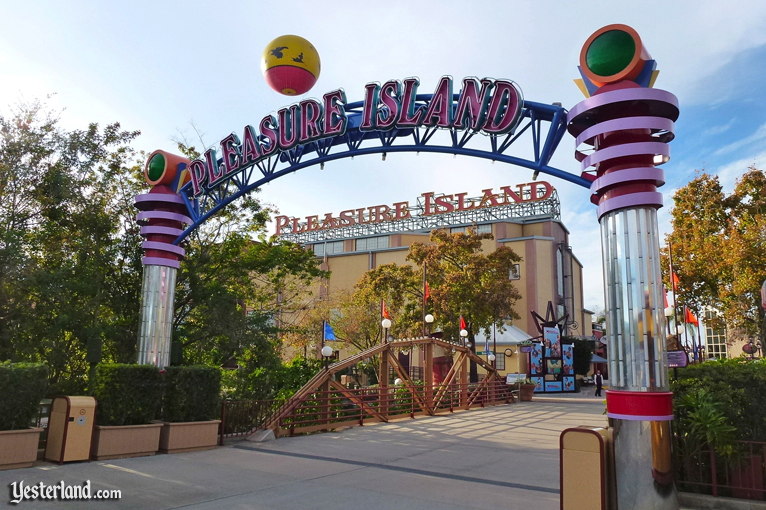
Photo by Werner Weiss, Jan. 9, 2012 Pleasure Island in 2012, more than three years after the clubs closed |
|||
|
Pleasure Island opened May 1, 1989. Taking a cue from the “adaptive reuse” trend, where old factory and warehouse districts are reborn as shopping and entertainment complexes, Disney purposely made Pleasure Island look like a hodgepodge of old waterfront structures. An elaborate backstory explained their origin. For 19 and a half years, guests enjoyed Pleasure Island and its “incredible nightclubs.” The clubs gave Walt Disney World guests and cast members a place to go for nighttime entertainment. For most of those years, there was even a New Year’s Eve show every night at 11:45 p.m., complete with fireworks. Two of the original clubs—Comedy Warehouse and (especially) The Adventurer’s Club—developed fiercely loyal repeat fans. Too many of those fans would nurse one beverage all evening while enjoying performances by professional entertainers. In an effort to make Pleasure Island a successful profit center, Disney fiddled with the mix of clubs and how guest access to the island worked. In 2005, one of the larger structures, the former Jazz Club, was leased to an outside company to become Raglan Road Irish Pub & Restaurant. Disney could collect hefty rent payments instead of running a club. But Disney was still stuck with the rest of Pleasure Island. |
|||
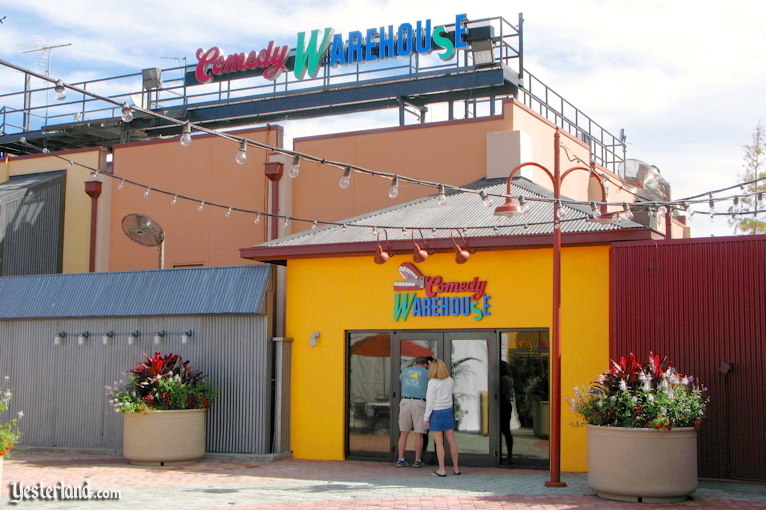
Photo by Werner Weiss, Nov. 9, 2008 Former Comedy Warehouse about six weeks after it closed |
|||
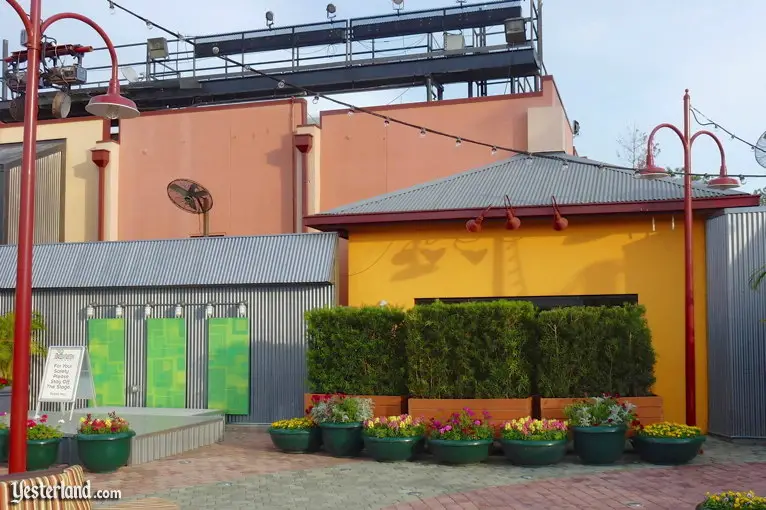
Photo by Werner Weiss, Jan. 9, 2012 Former Comedy Warehouse more than three years after it closed |
|||
|
The remaining clubs closed September 27, 2008. It was the end of Disney’s fiscal year during the worst economic downturn in the U.S. economy since the Great Depression. Now all Disney had to do was to find more tenants like Raglan Road. In 2009, an Orlando-area restaurant firm opened Paradiso 37, a bar and restaurant with food of the Americas, in what had been retail and fast food space. But that was it. The clubs remained unused except for occasional group rentals. Disney dressed up Pleasure Island with potted plants and flowers, but there was no hiding that the place was little more than an obstacle between the Marketplace and the West Side. The Pleasure Island brand was tainted. It was time for rebranding and a refresh. On November 18, 2010, Disney issued a press release announcing “a completely re-imagined Pleasure Island” called Hyperion Wharf, along with other enhancements to Downtown Disney. With serious unemployment problems in Central Florida, the press release proudly proclaimed, “Combined, the projects are expected to create an estimated 1,200 new jobs over the next three years.” |
|||
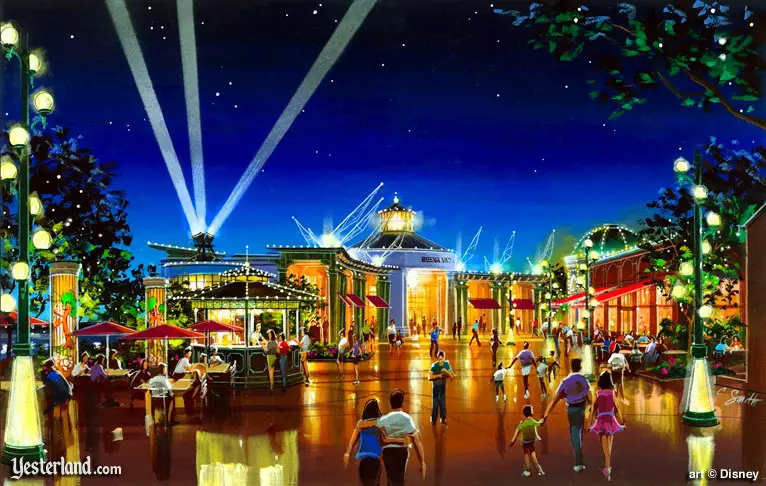
Concept art copyright Disney Concept art for Hyperion Wharf |
|||
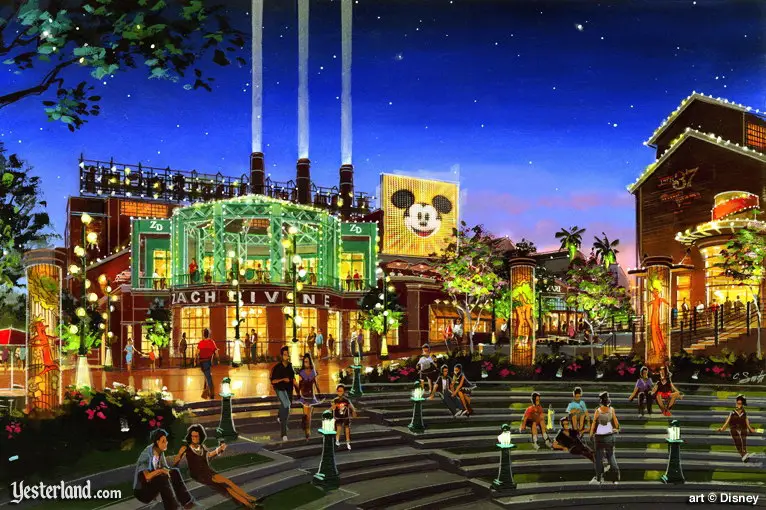
Concept art copyright Disney More concept art for Hyperion Wharf |
|||
|
Two key paragraphs in the press release described Hyperion Wharf: A nostalgic yet modern take on an early 20th century port city and amusement pier will evolve Pleasure Island into “Hyperion Wharf.” By day, the bustling port district will draw guests in with its stylish boutiques and innovative restaurants and by night, thousands of lights will transform the area into an electric wonderland. Taking its name from Hyperion, the Greek god of light, as well as the street on which Walt Disney built his first major animation studio, the wharf district also will feature a relaxing lakeside park and enhanced pedestrian walkways. Its diverse eateries will expand dining availability at Downtown Disney by more than 25 percent. But the real clue to what Disney was planning came from the concept art that accompanied the press release. |
|||
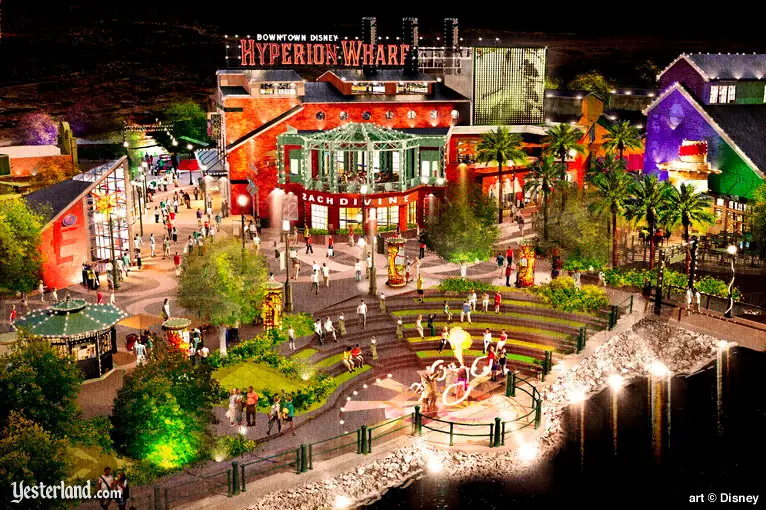
Concept art copyright Disney Former Mannequins (top center) |
|||
|
Pleasure Island had been designed to look like a wharf district with eclectic touches. The new name, Hyperion Wharf, embraced that theme rather than trying to hide from it. It would still be the hodgepodge of waterfront structures. Essentially, the buildings of Pleasure Island would be reused by Hyperion Wharf. For example, the building with the rooftop Hyperion Wharf sign was recognizable as the former Mannequins Dance Palace. But where the Rock & Roll Beach Club had been, a small amphitheater would face the waterfront. Rows of white lights would line the edges of the buildings. There would be new lighting, new pavement, new landscaping, new architectural elements, new signs—and, most importantly, new businesses to fill the many vacancies. At least that was the plan. |
|||
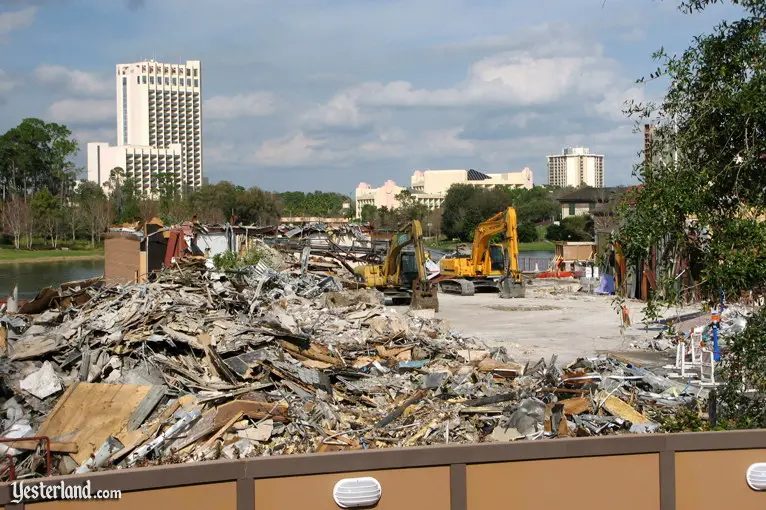
Photo by Werner Weiss, Feb. 4, 2011 Demolition |
|||
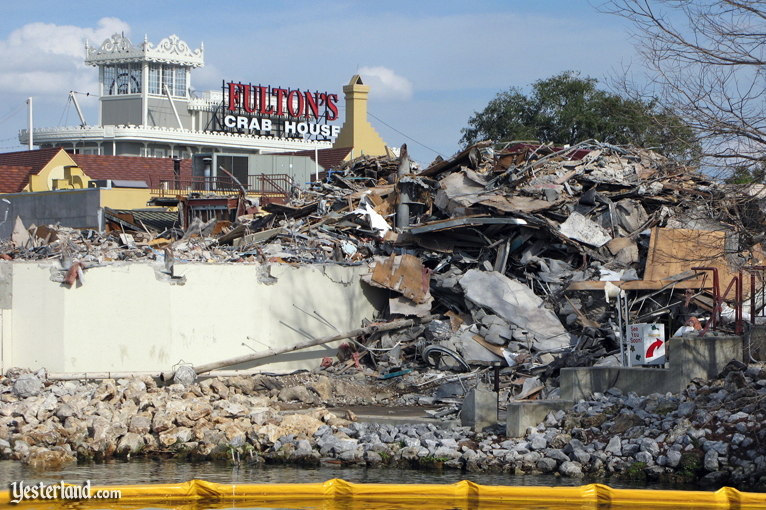
Photo by Werner Weiss, Feb. 4, 2011 Debris ready to be hauled off. |
|||
|
It soon looked as if the plan was moving full speed ahead. In February 2011, Motion and Rock & Roll Beach Club were demolished. The name of the area continued to be Pleasure Island—presumably only until the time was right to rebrand. But then a funny thing happened... Nothing. Or at least almost nothing. (An Apricot Lane boutique opened during summer 2011.) |
|||
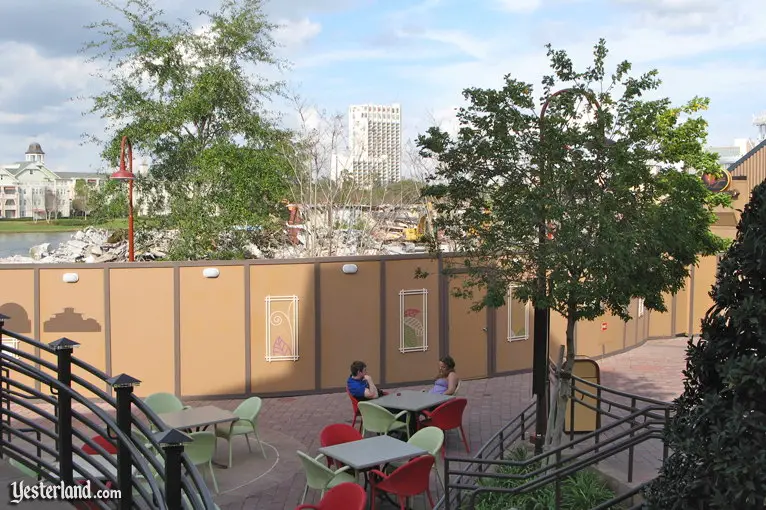
Photo by Werner Weiss, Feb. 4, 2011 View from Paradiso 37 during the demolition |
|||
|
Instead of building an amphitheater, Disney kept the wooden wall around the newly vacant demolition site. Where was the rest of the refresh? Where was the rebranding? Where were the tenants creating new restaurants and shops in the vacant structures? It seemed that prospective tenants were no more interested in the property than they were before the Hyperion Wharf announcement. Disney apparently decided not to throw more money at the project under these circumstances. The Pleasure Island signs stayed up. |
|||
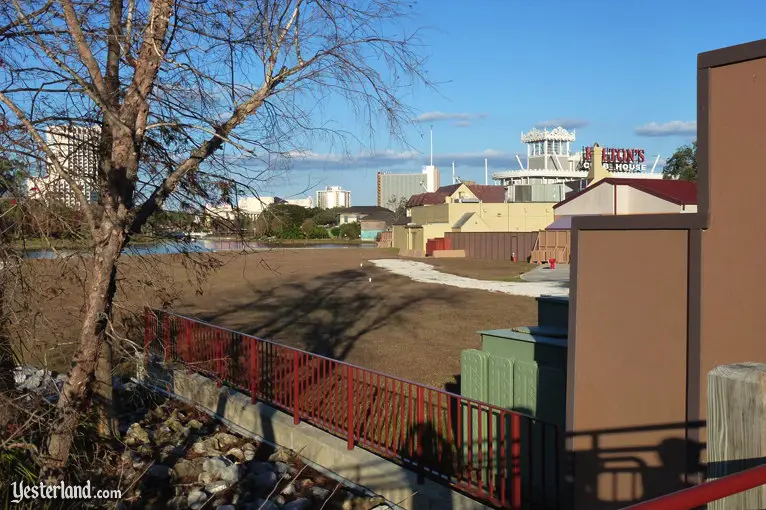
Photo by Werner Weiss, Jan. 8, 2012 Neatly mowed vacant lot where Rock & Roll Beach Club had been |
|||
|
On July 13, 2011, the Orlando Sentinel reported on the status of the project (“Disney’s Pleasure Island makeover stalls” by Jason Garcia): Walt Disney World’s slow-moving makeover of Pleasure Island has stalled again. The giant resort disclosed this week that construction of “Hyperion Wharf”—a dockside-themed shopping and dining area that was to replace Pleasure Island and its long-shuttered nightclubs—has been delayed indefinitely as the company re-evaluates plans for the site. The move comes barely half a year after Disney unveiled the Hyperion Wharf concept. The resort recently demolished some of Pleasure Island’s clubs, all of which have been closed since 2008. With Pleasure Island alive in name only, some sort of refresh was still needed. It turned out that Disney was hatching a bigger and better plan. |
|||
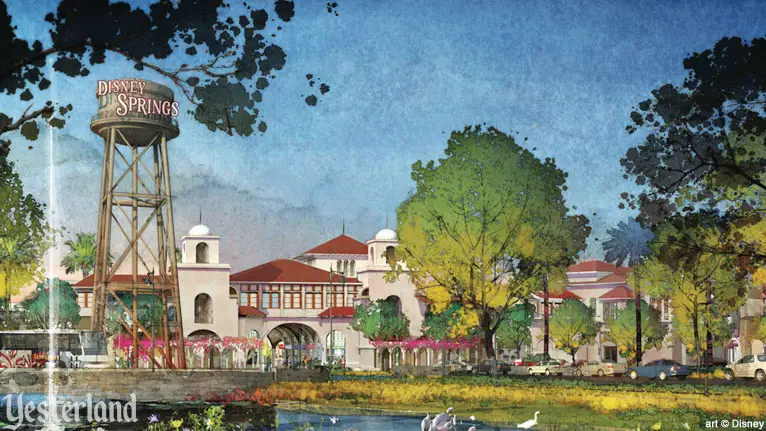
Concept art copyright Disney Concept art for the signature water tower at Disney Springs |
|||
|
On March 14, 2013, Disney unveiled its new vision. All of Downtown Disney would become Disney Springs. This time the project would not just be a Band-Aid applied to Pleasure Island, but a significant enhancement to the entire Downtown Disney guest experience. |
|||
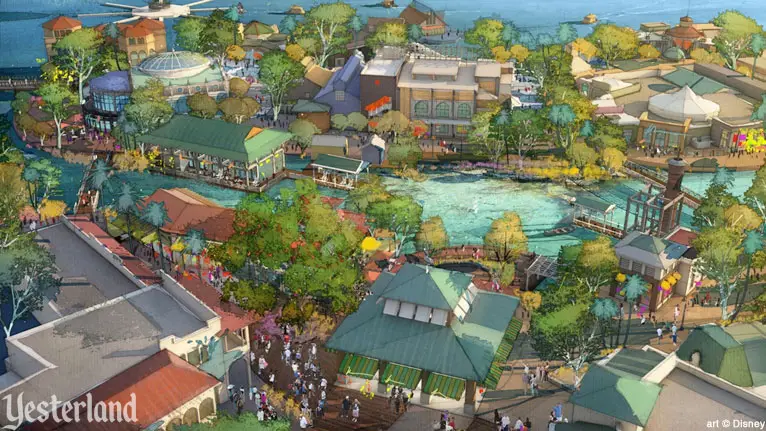
Concept art copyright Disney Concept art for The Landing (top) and The Town Center (bottom) |
|||
|
Pleasure Island, still with its waterfront theme, would become The Landing with a combination of new and reused structures. In front of The Landing, an entirely new neighborhood, The Town Center, would replace a surface parking lot. There would be new retail and dining space, along with a signature water tower. A flowing spring between The Landing and The Town Center would be the centerpiece of Disney Springs and the reason for its name. The press release described the role of the spring and the reason for it: “Drawing inspiration from Florida’s waterfront towns and natural beauty, Disney Springs will include four outdoor neighborhoods interconnected by a flowing spring and vibrant lakefront.” It was a good early Florida theme. Florida is home to numerous natural springs that were destinations long before there was Walt Disney World. Downtown Disney had consisted of three disjointed parts. The sparkling springs and The Town Center were supposed to tie everything together. |
|||
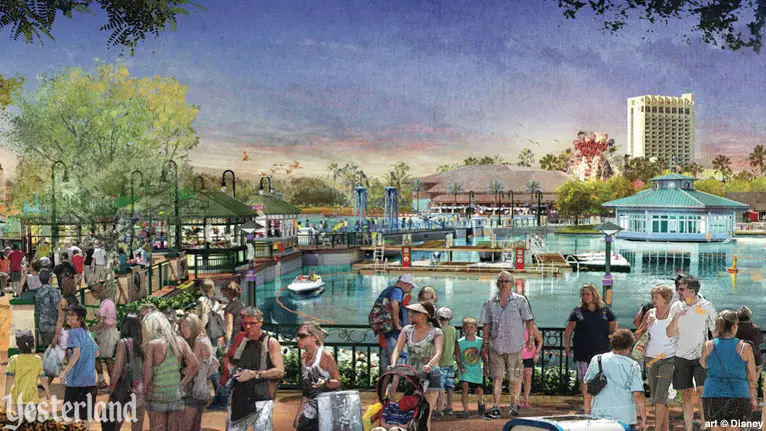
Concept art copyright Disney Concept art for the pedestrian causeway at The Marketplace |
|||
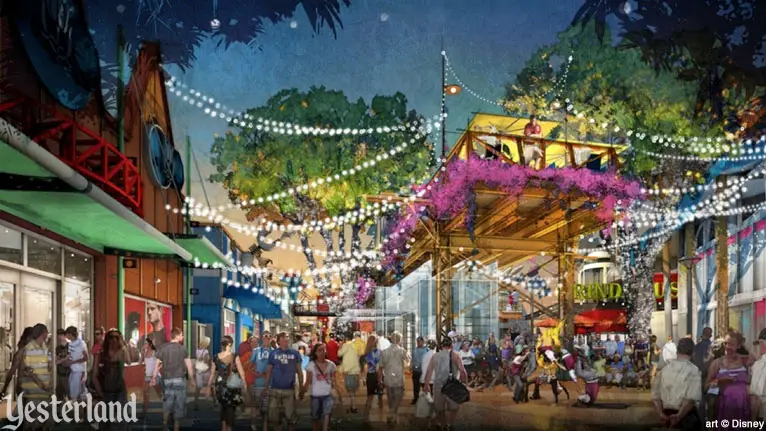
Concept art copyright Disney Concept art for elevated structures at The West Side |
|||
|
The other two neighborhoods of Disney Springs would remain The Marketplace and The West Side, but would be refreshed. Enhancements to The Marketplace would include an over-the-water pedestrian causeway, providing a shortcut across the cove. The West Side would gain elevated structures modeled after repurposed elevated train tracks such as New York’s High Line park. Plans also included huge parking structures, widening Buena Vista Drive, and even adding direct access from Interstate 4. |
|||
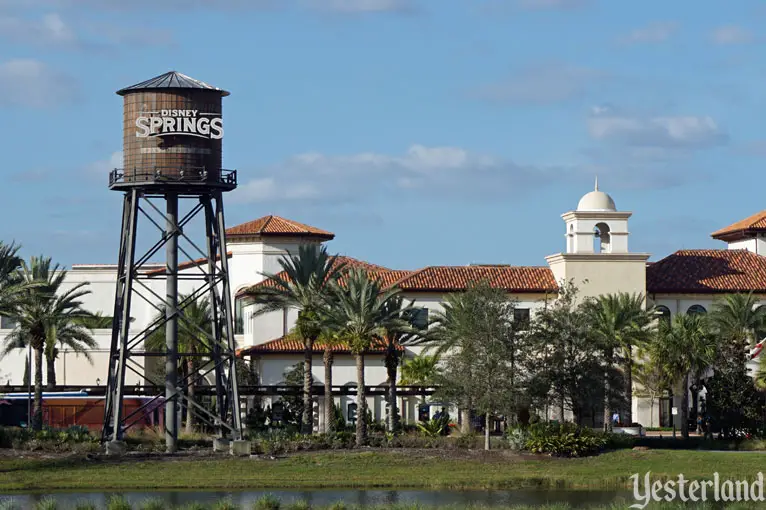
Photo by Werner Weiss, 2020 Signature water tower at Disney Springs, looking much like the concept art |
|||
|
On September 29, 2015, Downtown Disney became Disney Springs. The former Pleasure Island was coming back to life. Jock Lindsey’s Hangar Bar had opened a few days earlier, and Morimoto Asia would open the next day. But the full transition took years. The Boathouse had opened April 15, 2015, while Maria & Enzo’s Ristorante, Enzo’s Hideaway, and The Edison would not open until January 2018. |
|||
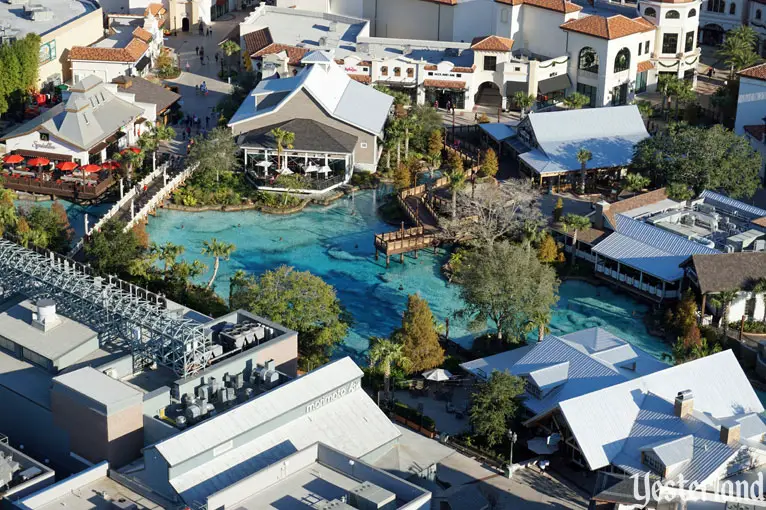
Photo by Werner Weiss, 2016 Disney Springs from the Characters in Flight balloon |
|||
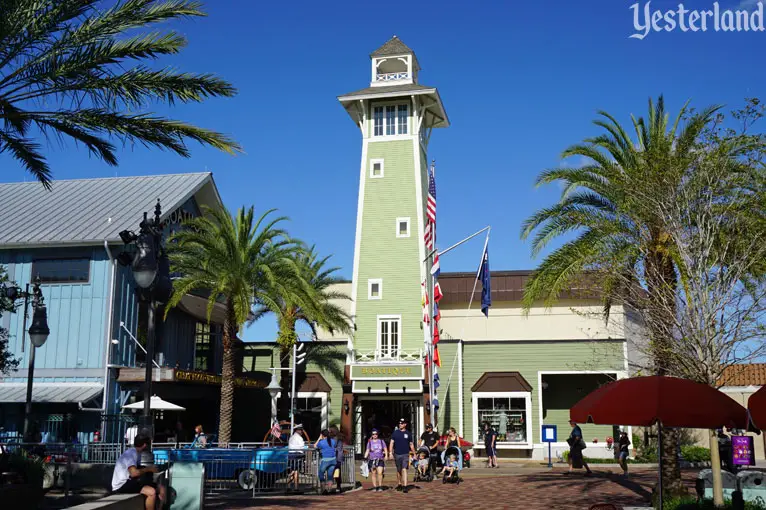
Photo by Werner Weiss, 2020 Boat House Restaurant at the Landing |
|||
|
Disney Springs has an elborate backstory. The year was 1850, and… You’ll have to wait for a future Yesterland article for more of the story. |
|||
|
|
Click here to post comments at MiceChat about this article.
© 2013-2020 Werner Weiss — Disclaimers, Copyright, and Trademarks Updated February 21, 2020. |
||
